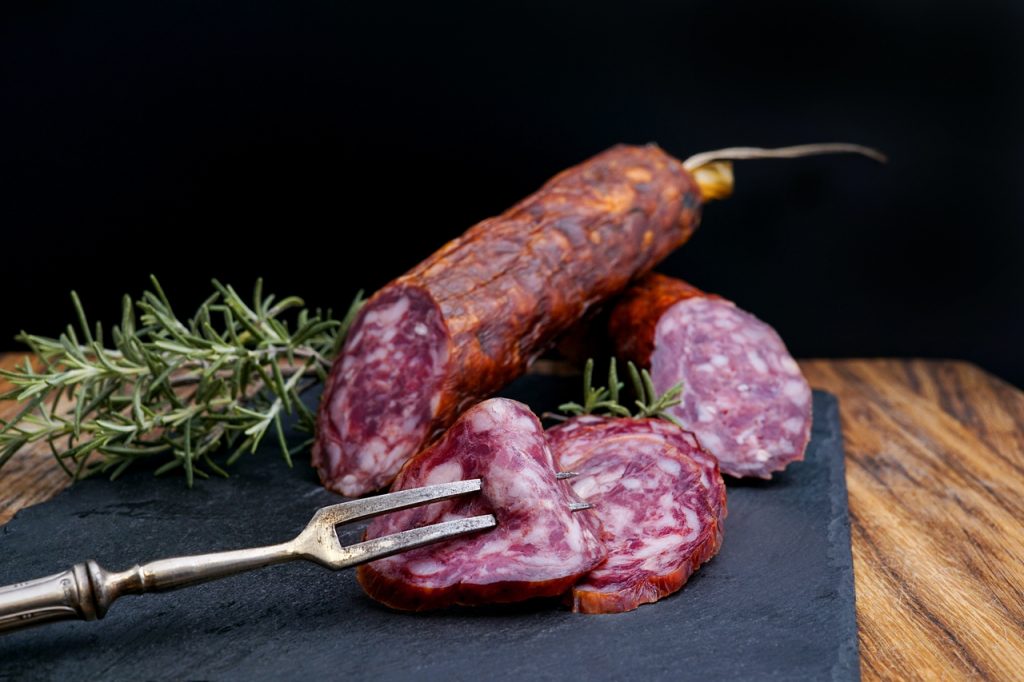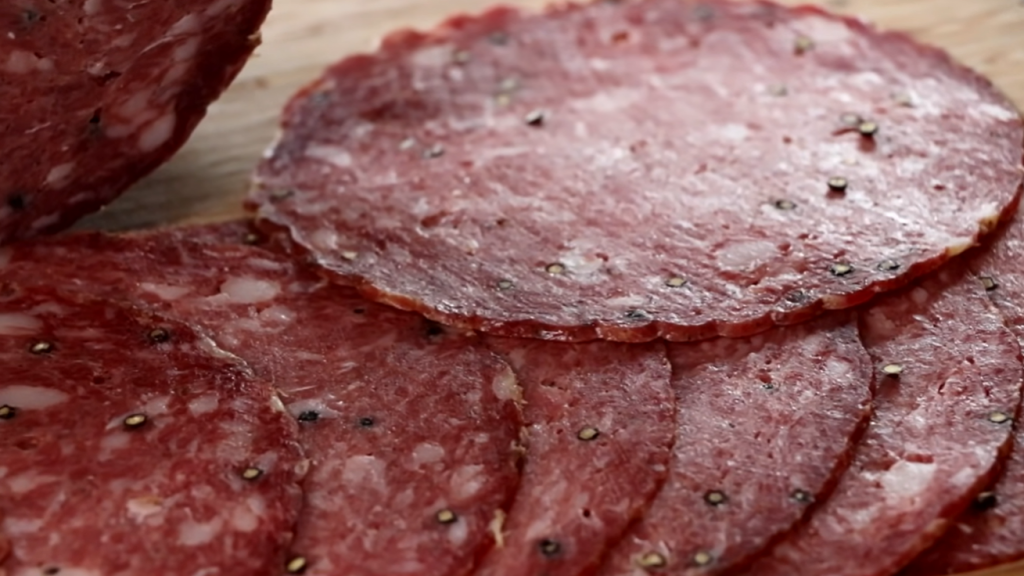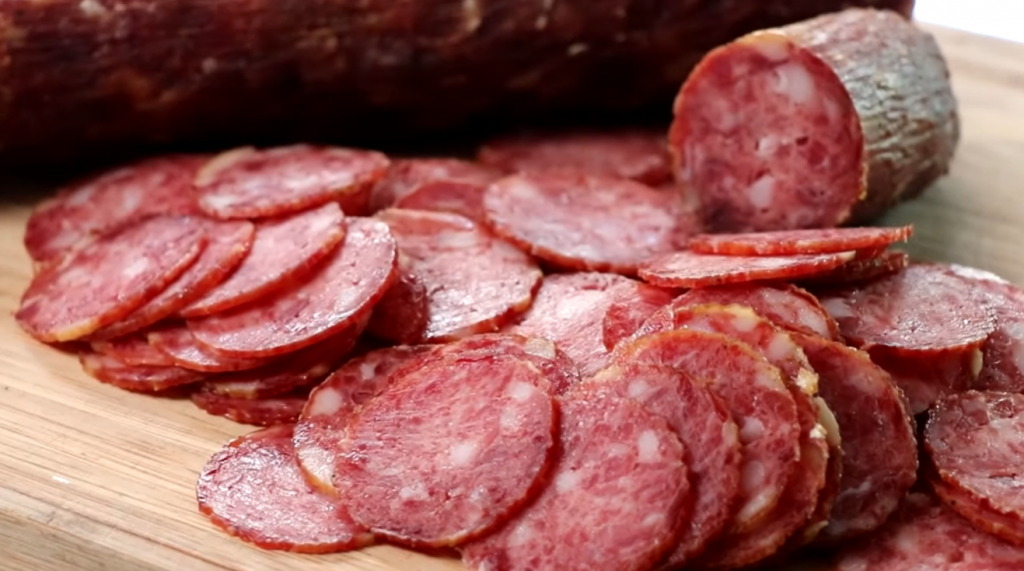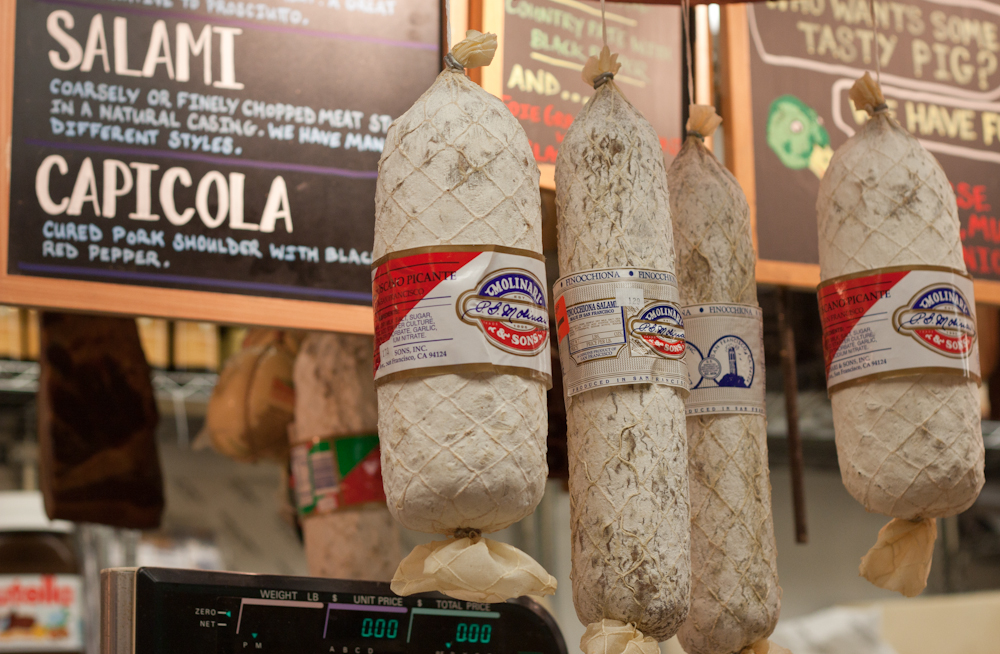
What’s the difference between Genoa salami vs hard salami? When making a charcuterie board, you’ve probably encountered these two salami types. Curious about what sets these two treats apart? You should! Knowing their differences will help you use them at their best. Below is a list of their differences, from their origins to their characteristics, for you to learn about.
What Is The Difference Between Genoa Salami vs Hard Salami?
| Characteristics | Genoa Salami | Hard Salami |
| Origin | Genoa, Italy | Central Europe (Germany, Poland, Czech Republic) |
| Ingredients | Pork (or beef/veal), garlic, peppercorns, wine, vinegar | Pork/beef (or both), pepper, and garlic |
| Making Process | Cured and air dried | Cured, air dried, and smoked |
| Appearance | Bright red with specs of fat | Lighter than Genoa salami, with little bits of white mold |
| Flavor and Texture | Soft, greasy, and fatty | Firm, chewy, and dry |
| Storing and Shelf Life | Refrigerated, can last up to 3 weeks | Air-dried, can last for a few weeks to months |
Salami is cured sausage. It is ground meat stuffed in a casing made from animal intestines that undergoes curing, fermentation, and drying. It is a well-known meat preservation process in the European regions. Italy, in particular, takes Italian salami-making seriously. They follow intricate procedures in making these delicious treats.
These cured delicatessens are widely available in specialty stores, supermarkets, and deli shops. There you will find several types of salami options. Each has distinct characteristics that set them apart, just like the differences between Genoa and hard salami.
Eager to explore what makes them different? Here’s a breakdown of their differences to help you!
Origin
The first significant difference between hard salami vs Genoa salami is their origin. Genoa salami, based on its name, is from Genoa, Italy. Meanwhile, hard salami is from Central Europe. Its country of origin is hard to pinpoint. Some claims it is from Germany, while others say it is native to Poland and the Czech Republic.
Ingredients
You can use pork, beef, or veal in making Genoa salami. Meanwhile, pork and beef are common ingredients in making hard salami.
Pork is the standard base ingredient for most salamis. As for Genoa salami, makers prefer to use pork as cattle raising is quite difficult in that region. However, there are varieties of Genoa salami that use beef and veal. How so? Well, unlike other Italian salami, this sort doesn’t have a protected designation of origin (PDO), meaning it can be produced outside its region and country.
With that, some salami makers use other meat options available in their area. That is how different Genoa salami varieties emerged. But aside from the meat, other ingredients for this salami include garlic, peppercorns, red wine, and vinegar.
On the other hand, hard salami uses pork and beef as base ingredients. Makers use pepper and garlic to season the meat before undergoing the curing process. They also create this salami using a combination of pork and beef. In the process, makers usually prefer beef over pork since it is less fatty.
Making Process
There are three significant steps in making salami: preparation of raw materials, fermentation, and drying. Both Genoa and hard salami undergo these stages. Genoa salami undergoes air drying right after curing. Meanwhile, hard salami undergoes an additional step which is smoking.
Salami makers combine seasonings and spices with the meat during the preparation process. They also add lactic acid bacteria as culture starters to help introduce good bacteria into the meat. They then encase this mixture in a casing made of animal intestines. After the curing process, Genoa salami undergoes air drying in an area with controlled temperature and humidity. This process usually takes two to three months.
For hard salami, there is an additional step. After curing, hard salami undergoes smoking to hasten its fermentation process. Makers smoke this delicatessen for about 48 to 96 hours. It then undergoes a dehydration process to dry thoroughly. This is a crucial step to avoid the build-up of bacteria that causes food contamination. It also follows the FSIS Identity Standards stating that hard salami should have a moisture and protein ratio of 1.9 to 1.
Appearance
Genoa salami has a red color with visible specs of fat. It is also smaller compared to hard salami which has a color that ranges from light pink to red with little scattered bits and pieces of white molds.

Genoa salami
Genoa salami’s red color is reminiscent of another notable salami: pepperoni. It uses coarsely ground meat fat, so you may see specs of it scattered in every slice.

Thinly sliced hard salami
Contrastingly, hard salami is a bit lighter than Genoa salami with its pale pink to red color. You will also notice some tiny white specs. But compared to the previous salami, these are no slices of fat but minute pieces of mold. Worry not, they are safe to eat.
Flavor and Texture
The soft and oily Genoa salami has a more complex taste and texture than the smoky taste of hard salami.
Genoa salami has different seasonings and spices, plus added wine and vinegar. These give this salami a complex flavor range. It is garlicky with a tangy and sharp taste courtesy of the wine and vinegar combination. This cured treat also has a slight creep of heat from the peppercorns.
Plus, this kind usually follows the typical 60:40 ratio of lean parts to fat for salami. That is why it has a soft, slightly greasy, and moist texture. And while it looks a lot similar to pepperoni, they differ completely. Pepperoni is spicier and grainier compared to Genoa salami.
Conversely, hard salami has a deep smoky flavor from the smoking process. And since it contains less fat, it has a dry and chewy texture. It also lives up to its name since it is indeed very firm.
Nutritional Value
Genoa and hard salami should be consumed in moderation. This is because they both have high sodium content. But macronutrient-wise, carbs per 2 ounces of Genoa salami is 0.4 grams. It also has 17.9 grams of fat, 11 grams of protein, and 214 calories. On the other hand, hard salami has 1 gram of carbohydrates, 16 grams of fat, 11 grams of protein, and 200 calories, which is a wee smaller than Genoa salami.
Shelf Life and Storage

Jonti Bolles | Flickr
Genoa salami has shorter shelf life than hard salami.
Once opened, most salamis last up to six months. That is if they were appropriately left sealed and stored. Genoa salami is a bit different. It is advisable to refrigerate this salami to extend its shelf life. We recommend wrapping it with butcher paper or parchment paper before storing it in the refrigerator to stretch its shelf life to about three weeks.
On the other hand, you don’t need to refrigerate smoked salami like hard salami. You can just air-dry it or keep it stored in a cool dry place. Doing this will help make it last for a few weeks to months.
But do note, that it’s always best to follow the expiration date printed on the packaging. Also, do not consume salami if you notice discoloration, graying edges, black fuzzy spots, and a foul smell.
Ways to Eat Genoa Salami and Hard Salami

Both salamis are versatile cured meats that you can use interchangeably. They are a perfect go-to cold meat that you can add to a platter of antipasto. However, Genoa salami is perfect with mild-tasting food to highlight its complex flavors. Hard salami, in contrast, complements delicate but scrumptious food.
Genoa salami has a complex blend of different flavors. This makes it a perfect pizza topping together with some mozzarella. You can also use this as a meat ingredient for your pasta dishes, stromboli, or calzone. Feeling fancy? Bring out a bottle of Chenin Blanc or a medium-bodied Pinot Noir. The sharp, tart flavor of these wines complements this cured treat.
Meanwhile, hard salami’s smoky flavor complements rich flavored food like salads, subs, and cream cheese. You can also pair it with meat and different types of cheese while drinking a glass of Chardonnay or a full-bodied red Cabernet Sauvignon.
Recipes With Genoa Salami

- Italian Sub Sandwich – Elevate your sub sandwich with some flavorful Genoa salami. Make it meatier by adding your other favorite cured meats while also including some veggies to make it fresh.
- Italian Chopped Salad – Add some Italian taste to your healthy salads. The richness of Genoa salami complements the refreshing mix of tomatoes, cucumber, and lettuce.
- Easy Stuffed Stromboli – You can easily make this Italian-American snack by stuffing a pizza dough with some meaty and cheesy goodness. Want some added spice? Adjust the amount of roasted red peppers for that added kick!
Recipes With Hard Salami
- Hot Muffuletta Sandwich – Level up your sandwich by layering meat and cheese with aromatic herbs and seasonings. It’s a snack you can easily pack for work or school!
- Potato, Salami, and Cheese Frittata – Whether it’s breakfast or brunch, this frittata recipe will definitely wow the crowd. Surprise your family with this creamy and savory dish made with cheese, potatoes, and smoky salami.
- Roasted Green Bean and Potato Salad – The hard salami’s smokiness matches the potatoes’ creaminess and the green beans’ savory goodness. It is perfect for those who love different textures in their salad.
Frequently Asked Questions
How to tell salami vs pepperoni vs capicola apart?
Pepperoni is a salami that is created by Italian-American salumists that wanted a more efficient way of crafting cured meats. Its base ingredient is a mix of pork and beef. It is red in color and has a smoky and spicy kick.
Now, what is capicola? It is a cured slab of muscle from a pig’s neck or shoulder portion, a bit different from salami’s ground meat. It is smoky and fatty when it comes to flavor.
What's the difference between Genoa salami vs soppressata?
Soppressata has a protected designation of origin. This means that, unlike Genoa salami, it can only be produced in certain parts or areas of Italy. Soppressata has more sweet, aromatic, and spicy flavors than Genoa salami.
What is the white coating on cured meat?
The white stuff or coating on your cured meat is mold called penicillin. Worry not! It is a good mold that helps preserve your cured treat. You usually peel this before consuming your salami.
Genoa Salami vs Hard Salami: Which is Better?
The answer to this question depends on your preference. If you want the soft, tangy taste in your sandwiches, salads, or pasta, grab and use that Genoa salami. But if you are looking for a chewy, mild, and smoky taste, you can never go wrong with hard salami. Enjoy whatever pleases your palate. But whatever you choose, always remember that like all other things, take it in moderation.











